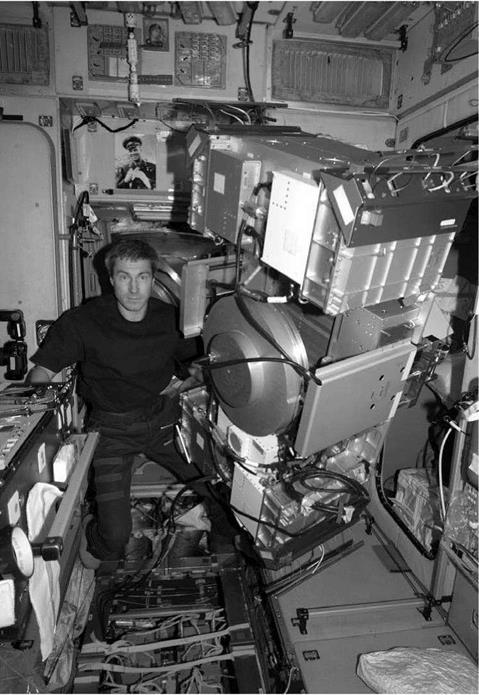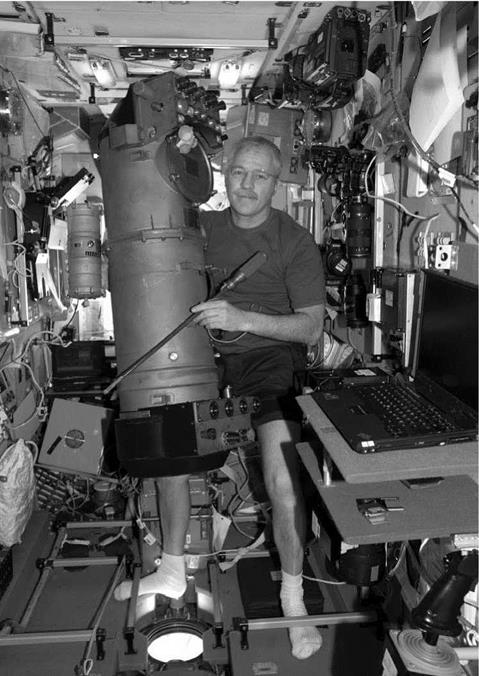EXPEDITION-11
During their first week alone on ISS, Krikalev worked on the condensate removal system of the Elektron oxygen generation system, which continued to be off-line. He also completed the transfer of water to the station from the docked Progress M-52. On April 29, the Expedition-11 crew were informed that the launch of STS-114, then planned for May 22, had been delayed until “no earlier than July 13’’. This was due to a requirement to spend additional time studying the potential for ice damage on the underside of the orbiter caused by ice falling from the Shuttle’s External Tank. Onboard ISS, both men continued to prepare for the arrival of STS-114. Included in the preparations was work with a digital camera that would be used to photograph the underside of the approaching orbiter, Discovery. They also cleared cargo away from the hatch in Unity that would be used to access the MPLM that Discovery would bring up to the station. Meanwhile, the Soyuz TMA-5 crew had been returned to the Gagarin Cosmonaut Training Centre outside Moscow, where they were reunited with their families.
In the following week Krikalev cleared a blockage in the Russian de-humidifier system and transferred waste water from the station’s storage tank to Progress M-52. He also replaced a liquid-processing component of the Elektron oxygen-generating system, but it failed almost immediately. The crew continued to burn two SFOGs per day, as had occurred during the hand-over period when additional oxygen was required. Phillips packed items to be returned to Earth on STS-114, and repaired a treadmill that had stopped working. Both men participated in experiments and practised with the SSRMS, putting it through a series of manoeuvres that would allow operators on the ground to operate the arm remotely in the future. During an exercise period at the end of the week the treadmill stopped working when a circuit breaker tripped.
The crew observed Victory Day, the Russian 60th anniversary of the end of the Great Patriotic War (World War II) on May 8. In the following week, a monthly inspection of the treadmill revealed a broken restraint cable and the crew were instructed to use alternative exercise equipment until they could repair the cable, on May 16. Oxygen from Progress M-52 was used to repressurise the station, and on May 11 the thrusters on Progress M-52 were used to raise the station’s orbit. The remainder of the week was spent preparing for the arrival of STS-114, updating software on the station’s computers and performing experiments.
At this time, future access to ISS was the subject of an announcement by a spokesman from Roscosmos Space Agency. Russia had carried the financial responsibility of keeping ISS occupied and supplied since the loss of STS-107 and were seeking recompense. With the Russian contract to provide Soyuz and Progress spacecraft to the station outside of the Iran Non-proliferation Act due to end in April 2006, the Russians repeated that after that date Soyuz spacecraft would only carry Russian cosmonauts and paying passengers into space. They also demanded that Russian cosmonauts no longer be made to perform American experiments in lieu of the American money used to complete the building and launch of Zvezda. The relationship between the two major partners was beginning to change.
On May 20, Florida Today carried an article entitled, “NASA may have to abandon station.’’ The article quoted US Representative Sherwood Boehlert as saying, “If we don’t have agreement with the Russians, then we won’t be able to have people in space for long periods of time.’’ The article went on to explain the details of how and why the Iran Non-proliferation Act had been set up in 2000, but 11 Soyuz spacecraft for ISS were exempted because they were already contracted for. Luckily, those spacecraft had been available to keep ISS occupied following the loss of STS-107 in February 2003, but the last of those 11 Soyuz was due to be launched in
|
Figure 56. Expedition-11: Sergei Krikalev works on the TVIS in Zvezda. |
September 2005 and return to Earth in April 2006. After that date Russia was under no obligation to launch American astronauts to ISS, or recover them from the station, including acting as CRV for American astronauts. The article suggested that, if no new contract with the Russians was signed, then American astronauts would only be able to occupy ISS when the Shuttle was present and even then the Russians would be under no obligation to recover American astronauts if the Shuttle, or ISS, malfunctioned while they were onboard. If the Russians chose to apply the letter of their contract then American astronauts would be restricted to occupation periods of just 2 or 3 weeks and would have no access to ISS between the Shuttle programme ending in 2010 and the first flight of the new Crew Exploration Vehicle.
On May 17 the Expedition-11 crew removed the contents of the Quest airlock and PMA-2 before depressurising both modules in a rehearsal of procedures that would conserve the station’s nitrogen supply during the visit of STS-114. Over the following two days the station was repressurised using the last of the oxygen held in Progress M-52. They also conducted test ignitions on two of the station’s SFOG oxygen-generating candles. Throughout the week both men performed a variety of experiments and Phillips wore the FOOT instrumented leggings, recording data for that experiment.
During the third week of May, both crew members performed a number of medical and microgravity experiments. They also practised further with the cameras that they would use to photograph STS-114 during its approach to the station. They also continued to burn SFOG candles to replenish the oxygen inside the station. Krikalev worked on the Elektron oxygen generator, providing additional data for the engineers at Korolev. His work identified that the electrolyser showed no voltage and was presumed to have failed. Krikalev also worked to bypass a blockage in the condenser system of the Russian modules.
On June 3 the final series of tests were completed to give the Robotics Officer in Houston control of the SSRMS. During the tests the arm was commanded to move out, latch onto a fixture on the exterior of ISS, then unlatch, and move back to its parked position. Phillips monitored the test from the SSRMS station in Destiny. Following instructions from Korolev, Krikalev continued to work on the Elektron, to add to the data available to Russian engineers. Meanwhile, the Expedition-11 crew continued to burn two SFOG candles a day. Phillips also continued to work on a number of microgravity experiments.
Preparations for the undocking of Progress M-52 began during the second week of June. The crew spent the week packing the Progress with items of rubbish. Progress transferred 217 kg of propellants to Zvezda’s tanks on June 6. Four days later, the crew were able to photograph Tropical Storm Arlene. Krikalev swapped the liquid unit in the Elektron, in preparation for the arrival of filters and gas lines due to be delivered on Progress M-54. Phillips performed medical experiments to measure muscle tone, for comparison with data recorded before he was launched into space. Progress M-52 undocked at 16: 16, June 15 and was de-orbited, to burn up in the atmosphere, later the same day. In Moscow, Expedition-9 Commander Gennady Padalka told journalists, “The station is very overloaded, with cosmonauts using all nooks for keeping cargoes which await return trips in US Shuttles.’’
|
Figure 57. Expedition-11: John Phillips works on the Elektron oxygen generator in Zvezda. Note the window beneath his right foot. |












